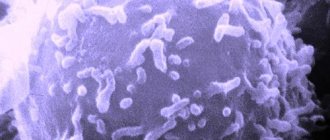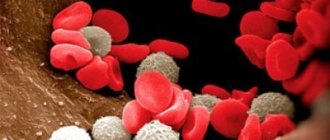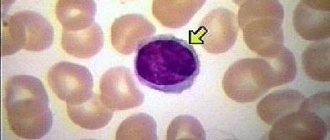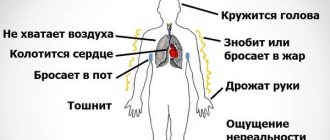What is lymphocytic leukemia?
Lymphocytic leukemia is a malignant lesion that occurs in the lymphatic tissue. Characterized by pathological changes in lymphocytes.
Read more about the norm of lymphocytes in the blood in this article.
The disease negatively affects not only white blood cells, but also the bone marrow, peripheral blood and lymphoid organs. The patient's condition is rapidly deteriorating. The pathology is most widespread in Western Europe, the USA and Canada. Almost never found in Asian countries.
Thanks to continuous blood flow, malignant cells quickly spread through the blood and immune system organs.
This leads to massive infection of the entire body .
A huge danger for humans is that the formed cancer cells begin to divide . This happens uncontrollably. They invade healthy neighboring tissues and lead to their disease. This explains the rapid development of the disease and the sharp deterioration in human health.
ICD-10 code: C91.
Symptoms
Symptoms of lymphocytic leukemia do not always give rise to suspicion. They are expressed in significant weakness, loss of appetite, increased sweating, decreased resistance and a tendency to various diseases. Laboratory tests make it possible to detect anemia and thrombocytopenia, a decrease in the number of neutrophils, and the presence of pathological cells in the peripheral blood. Often the disease is detected during rheumatology research or therapy when pathology of the hepatobiliary system is suspected. But the main signs - an increase in lymph nodes and a sharp weakening of the immune system - lead to the need for a thorough examination.
We recommend reading Prolactinoma - what it is, causes and treatment
At-risk groups
In most cases, the disease affects children 2-5 years old . It is found much less frequently in adolescents. Children suffer from the disease with difficulty: in the early stages, fatigue and fatigue occur. Lymph nodes enlarge.
The child experiences sudden enlargement of the abdomen and joint pain . There are bruises on the body, they are often associated with increased child activity, clumsiness, bumps and falls during play.
Any scratch leads to heavy bleeding , and it can be incredibly difficult to stop the bleeding. At later stages, the child complains of severe headaches, feels sick, and may vomit. Body temperature rises significantly.
The disease rarely occurs in adults. It mainly affects people over 50 years of age . First of all, the spleen and liver are affected. These organs increase in size. There is pain and a feeling of heaviness.
Lymph nodes increase in size, causing discomfort and even pain. They compress the bronchi, which leads to severe coughing and shortness of breath.
The person feels weak and lethargic. His performance is reduced. Activation of chronic infection is possible.
Forms and stages of the disease
Doctors distinguish three stages of the disease:
- Initial. There is a slight increase in leukocytes in the blood. The size of the spleen remained virtually unchanged. The patient is monitored by doctors, but no medications are required. The examination is carried out regularly. This is necessary to monitor the patient's condition.
- Expanded. The main signs of pathology are present, treatment is necessary. The condition is unsatisfactory. The symptoms become more and more pronounced, causing pain and discomfort to the patient.
- Terminal. Bleeding and infectious complications are observed. The patient's condition is serious. The patient is being monitored in the hospital. Leaving the patient alone is dangerous, since his condition at this stage is extremely serious. You need the care and attention of doctors, as well as serious medications.
There are two forms of the disease:
- Spicy. The disease occurs suddenly and develops quickly. The symptoms are pronounced. It happens most often in children, which is why their health rapidly deteriorates. The child quickly weakens and becomes very ill.
- Chronic. The development of the disease occurs more slowly, at first the symptoms are practically invisible. Treatment takes a long time. Doctors' supervision is needed. Happens more often in adults. The disease can be observed for many years, and examinations are carried out regularly.
In turn, the chronic form is divided into several varieties:
- Benign . The enlargement of the lymph nodes and spleen occurs slowly. Life expectancy of patients: 30-40 years.
- Tumor . Patients' lymph nodes are greatly enlarged. Other symptoms are less pronounced.
- Progressive . The disease develops quickly, the symptoms are pronounced. Life expectancy is no more than 8 years.
- Bone marrow . Bone marrow damage occurs. Signs appear in the early stages of the disease.
- Splenomegalic . The spleen enlarges, and a feeling of heaviness is felt at its location. Other symptoms are less pronounced.
- A disease with complicated cytolytic syndrome . Mass death of tumor cells, poisoning of the body occurs.
- A disease that occurs with paraproteinemia . Tumor cells secrete a protein that is abnormal.
- T-shape . The pathology develops quickly and the skin suffers. Itching and redness may occur. Over time, the condition of the body worsens, and other symptoms of the disease appear.
- Hairy cell leukemia . Tumor cells have special outgrowths that resemble villi. Doctors pay special attention to them during diagnostics.
Learn more about chronic lymphocytic leukemia from the video:
Chronic lymphocytic leukemia
For many years, only lymphocytosis may be observed - 40-50%, although the total number of leukocytes fluctuates around the upper limit of normal. Lymph nodes can be of normal size, but they enlarge during various infections, and after the elimination of the inflammatory process they shrink to their original size.
Lymph nodes gradually enlarge, usually first of all in the neck, in the armpits, then the process spreads to the mediastinum, abdominal cavity, and groin area. Nonspecific phenomena common to all leukemia occur: increased fatigue, weakness, sweating. In the early stages of the disease, in most cases, anemia and thrombocytopenia do not develop.
Lymphocytosis in the blood gradually increases; 80-90% of lymphocytes, as a rule, are observed when the bone marrow is almost completely replaced by lymphocytes. The spread of lymphatic tissue in the bone marrow may not inhibit the production of normal cells for years. Even when high numbers of leukocytes in the blood are reached, 100,000 in 1 μl or more, there is often no anemia, the platelet count is normal or slightly reduced.
Bone marrow studies show an increase in the content of lymphocytes in the myelogram - usually more than 30%, and characteristic proliferations of lymphoid cells, often diffuse, are also noted.
The structure of lymphocytes in chronic lymphocytic leukemia does not have stable and typical features. It can change during the course of the disease under the influence of viral infections. Unlike other leukemias, the predominance in the blood of cells with the same name (in this case, lymphocytes) does not mean the predominance of leukemic cells, since both B-lymphocytes of the leukemic clone and an increased number of polyclonal T-lymphocytes are often simultaneously present in the circulation. In the blood, the majority of cells are mature lymphocytes, no different from normal ones. Along with such cells, there may be lymphocytic elements with a more homogeneous nucleus, which do not yet have the rough lumpiness of the chromatin of a mature lymphocyte, with a wide rim of cytoplasm, which sometimes, as in infectious mononucleosis, has perinuclear clearing. Cell nuclei may have a peculiar twisted loop or be regularly round; bean-shaped kernels are also found; the cytoplasm has fragmentary contours, sometimes with elements of “hairiness,” but without the histochemical features of hairy cell leukemia.
A characteristic sign of chronic lymphocytic leukemia is dilapidated nuclei of lymphocytes - Humnrecht's shadows. Their number does not indicate the severity of the process.
At the onset of the disease, there are usually no prolymphocytes or lymphocytes in the leukocyte formula.
On this basis, a prolymphocytic form of chronic lymphocytic leukemia is isolated. Sometimes such leukemia can occur with the secretion of monoclonal immunoglobulin.
As the disease progresses, single prolymphocytes and lymphoblasts begin to appear in the blood. A large number of them appear only in the terminal stage of the disease.
Stages of chronic lymphocytic leukemia. At the initial stage of the process, there is a slight increase in several lymph nodes of one or two groups, leukocytosis does not exceed 30 × 103 - 50 × 103 in 1 μl and, most importantly, over the course of months there is no tendency to a noticeable increase. At this stage, patients remain under the supervision of a hematologist, and cytostatic therapy is not carried out. The advanced stage is characterized by increasing leukocytosis, progressive or generalized enlargement of lymph nodes, the appearance of recurrent infections, and autoimmune cytopenias. This stage requires active therapy. The terminal stage includes cases of malignant transformation of chronic lymphocytic leukemia.
Diagnosis of chronic lymphocytic leukemia is not difficult. The criteria are as follows: absolute lymphocytosis in the blood, more than 30% of lymphocytes in the bone marrow aspirate with diffuse lymphatic hyperplasia in the bone marrow trephine. Enlargement of the lymph nodes and spleen is an optional sign of chronic lymphocytic leukemia, but when involved in the process, diffuse proliferation of lymphocytes is observed in these organs. An auxiliary diagnostic sign of lymphatic tumor proliferation is Gumprecht's shadows in a blood smear.
Chronic lymphocytic leukemia must be differentiated from another mature cell lymphocytic tumor process - lymphocytoma. It is distinguished from lymphocytoma by the predominant localization of lymphatic proliferation in the bone marrow and its diffuse nature in this organ, as well as in others involved in the process, confirmed by histological examination.
Complications
All 3 commonly tested immunoglobulins (A, G and M) or some of them may be reduced. During secreting lymphoproliferative processes, along with an increase in monoclonal immunoglobulin, the level of normal immunoglobulins usually decreases. In doubtful diagnostic situations, with low lymphocytosis, a decrease in the level of normal immunoglobulins can serve as an argument in favor of the lymphoproliferative process. However, a typical picture is possible with normal levels of γ-globulins and immunoglobulins in the blood serum. Hypogammaglobulinemia is not associated with the duration of the disease and the severity of lymphocytosis. It may be caused by a violation of the interaction of T- and B-lymphocytes, an increased content of T-suppressors, and the inability of leukemic B-lymphocytes to respond to lymphokines produced by normal T-lymphocytes.
Increased sensitivity to infection in patients with chronic lymphocytic leukemia is one of the most important factors leading to death. The reasons for this susceptibility are not entirely clear and there appear to be several. According to E.G. Bragina, the tendency to infectious complications is not always parallel to hypogammaglobulinemia; it can also occur with a normal level of γ-globulins in the serum. Frequent infectious complications do not always parallel the increase in leukocytosis.
The incidence of pneumonia, especially in chronic lymphocytic leukemia, is facilitated by lymphatic infiltration of the lung tissue itself, an increase in the lymphatic follicles of the bronchial tree, leading to collapse of all or part of the lung, disruption of pulmonary ventilation and drainage function of the bronchi. Typically, these phenomena increase as the disease progresses. Frequent complications are inflammatory processes in the fiber caused by staphylococcus or gram-negative bacteria.
At the same time, increased susceptibility to infection, which is defined by the term “infectiousness,” in the initial stage of the process is apparently associated with defects in the immune response and disturbances in the interaction of T- and B-lymphocytes. Insufficient courses may contribute to the recurrence and protracted course of infections
antibiotic therapy. In specialized hematology and oncology hospitals, where patients with severe immunosuppression accumulate and new pathogenic strains of pathogens appear, peculiar “epidemics” very often break out.
Most often, patients suffer from herpes zoster. It can be both typical and generalized, causing complete skin damage, while a local segmental rash of blisters quickly becomes confluent. Herpetic rashes can also affect the mucous membranes of the digestive tract and bronchi. The same lesion occurs with herpes simplex and chicken pox.
Patients with chronic lymphocytic leukemia often experience severe infiltration at the site of mosquito bites; With multiple bites, severe intoxication is possible.
Immune complex complications of chronic lymphocytic leukemia and other lymphoproliferative diseases are uncommon. They can be expressed by Schönlein-Henoch syndrome, polyneuritis.
In chronic lymphocytic leukemia, there is often infiltration of the VIII pair of cranial nerves with weakened hearing, a feeling of “stuffiness,” and tinnitus. As with other leukemias, the development of neuroleukemia is possible; as a rule, this is a terminal exacerbation when the meninges are infiltrated by young lymphoid cells. The clinical picture of neuroleukemia does not differ from that of acute leukemia; in the meninges, the process was eliminated by intralumbar administration of cytosar with methotrexate. Simultaneously with the infiltration of the meninges, infiltration of the brain substance may occur, the treatment of which requires irradiation. Radicular syndrome, caused by lymphatic infiltration of the roots, usually occurs in the terminal stage of the disease.
One of the severe manifestations of chronic lymphocytic leukemia is exudative pleurisy. Its nature can be different: para- or metapneumonic pleurisy with a banal infection, tuberculous pleurisy, lymphatic infiltration of the pleura, compression or rupture of the thoracic lymphatic duct. With pleurisy of infectious origin, there are many neutrophils in the exudate along with lymphocytes. With infiltration of the pleura, compression and rupture of the lymphatic duct, the exudate will be lymphatic, but if the fluid comes from the duct, it will contain a large amount of fat (chylous fluid).
Active treatment must be timely, since forced repeated removal of pleural exudate quite quickly leads to exhaustion and hypoalbuminemic edema. If the thoracic duct is ruptured, surgical restoration of its integrity is indicated.
Patients die mainly due to severe infectious complications, increasing exhaustion, bleeding, anemia, and sarcoma growth.
As a rule, with chronic lymphocytic leukemia there is no qualitative change in the behavior of tumor cells for a long time. There may be no signs of progression with the release of pathological cells from the control of cytostatic drugs throughout the entire disease.
If the process does enter the terminal stage, then it has the same symptoms as in other leukemias (suppression of normal hematopoietic germs, total replacement of bone marrow with blast cells).
Reasons for appearance
The causes of the occurrence and development of the disease are:
- Heredity . If one of your relatives has experienced this disease, the chances of developing a pathology increase several times.
- Down syndrome . Increases the risk of disease.
- Wiskott-Aldrich syndrome. Contributes to the development of the disease.
- Infectious and viral diseases in severe form. If a person has suffered such diseases, lymphocytic leukemia may arise as a complication.
- High doses of radiation. They lead to serious consequences, including the development of this disease.
If the radiation doses were very large, the patient's condition would deteriorate incredibly quickly. There is little chance of recovery. Such patients are almost immediately admitted to hospital for serious treatment. Medicines may be powerless; serious medical procedures are needed within the walls of the hospital. - Ingestion of chemicals in large quantities into the body . Such substances have a negative effect on the human body and lead to the development of serious diseases. Severe poisoning of the body occurs, which leads to this disease. The process may speed up if exposure to chemicals continues. It is very important to protect the patient from the negative effects of such substances.
The above factors lead to the occurrence of the disease. Cell mutation occurs when they begin to divide uncontrollably. The disease can develop for years, but a complete cure cannot be achieved.
The disease causes enormous harm to the body, from which it is not possible to fully recover. Modern medicine can stop the development of the disease and alleviate the patient's condition . However, there is a high probability of complications and exacerbation of pathology.
Treatment of patients is carried out under the strict supervision of a doctor. In the later stages of the disease, the patient is placed in a hospital for examination and more serious monitoring of his well-being.
Diagnostics
Diagnosis of the disease is carried out in the hospital. For this, the patient is examined. However, this is not enough to make a diagnosis.
Diagnostic methods are used, among which laboratory blood tests are of great importance. As a rule, it is blood tests of the patient that reveal the disease.
Among modern methods for diagnosing this disease, doctors distinguish:
- Blood analysis. A diagnostic indicator of the disease is an increase in the number of leukocytes in a blood test to 5 × 109/l. Characteristic changes in the immunophenotype of lymphocytes are observed.
- Red bone marrow examination. They help to understand the patient’s health status and track pathological changes in the body.
- Study of biopsy specimens of bone marrow, lymph nodes and spleen. They allow you to get acquainted in detail with the tissues of the body and their changes.
- Sternal puncture . It is one of the most effective, helping doctors study the patient’s body.
Lymphocytic leukemia treatment
Treatment for this disease is prescribed depending on the course of the disease and the characteristics of its manifestation. Treatment begins when the results of blood tests or symptoms show that the disease has already reached the point where it affects the patient’s quality of life.
If chronic lymphocytic leukemia develops very quickly, the following drugs are prescribed:
- cytostatics
- glucocorticoid hormones
- chemotherapy
- radiotherapy
- immunotherapy
- bone marrow transplant
In chemotherapy, it is common to use alkylating cytostatic drugs more often than others. Most often these are chlorobutin and cyclophosphamide. Sometimes steroids, such as prednisone, may be used.
In cases where leukemia, for example, causes obstruction, enlargement, or some other damage to an organ, radiation therapy can also be used.
Complications in the treatment of chronic lymphocytic leukemia
Among the most common complications are:
- urinary tract inflammation
- pneumonia
- sore throat
- abscess
- septic condition
Autoimmune processes are considered the most severe complication. Autoimmune hemolytic anemia occurs most often. It usually manifests itself in the form of a deterioration in the general condition of the patient, an increase in temperature, a decrease in hemoglobin and the appearance of mild jaundice.
Chronic lymphocytic leukemia can easily develop into hematosarcoma if the enlarged lymph nodes turn into a tumor.











